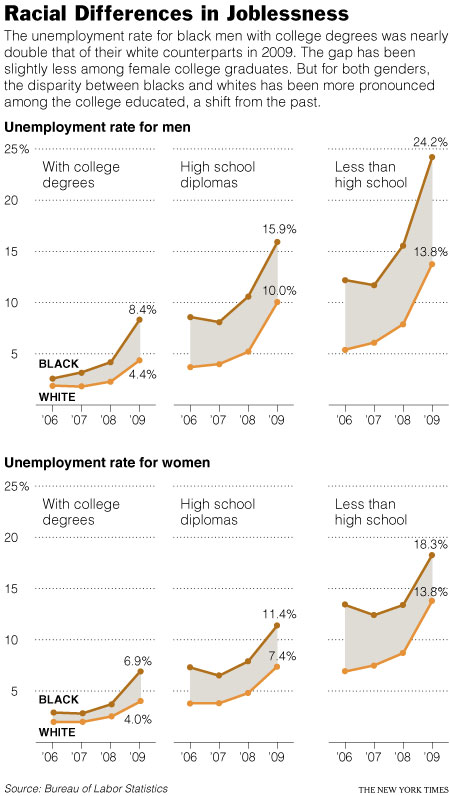This week the New York Times featured a story about joblessness rates among black and white men and women. As the figures below show, black men and women always face higher levels of unemployment compared to whites of the same education level; for men, the disparity increases as education level increases; and for black women, that pattern holds at least for 2009.

For more detailed data on this phenomenon, see our posts on race and the economic downturn, the intersection of race and criminal record, and education and unemployment.
Lisa Wade, PhD is an Associate Professor at Tulane University. She is the author of American Hookup, a book about college sexual culture; a textbook about gender; and a forthcoming introductory text: Terrible Magnificent Sociology. You can follow her on Twitter and Instagram.
Comments 15
blackjoblesswoman — December 7, 2009
I don´t think it is fair to look at race and unemployment without considering other factors. Granted, I didn´t read the "more detailed data on this phenomenon," but these graphs make no distinctions between someone with an AA, BA, MA, AS, BS, MS, etc. Of course a black person with an AA is going to have a harder time finding a job than a white person with an MS, and that has nothing to do with race.
I am not denying the fact that racism still exists in the job market, I just have a hard time drawing conclusions from the way this data is presented.
Little Bumble Bee — December 7, 2009
I think that it is also interesting that women are consistently less likely to be unemployed than men according to these stats.
Jamie — December 7, 2009
That's also interesting because the news has been saying constantly that women are getting and keeping jobs in this economy, while men are being laid off.
E — December 8, 2009
Really??? Is this really news to you? Do you really need more data? You really haven't seen enough? Is this one article going to make it or break it for you. Is this really the only data you have seen like this? Books are published, dissertations finished on these subjects daily (well, maybe not daily for the dissertations). Granted this one article isn't very detailed. But if you are relying only on this article and don't know these things already, I have to wonder where you've been.
E — December 8, 2009
what bugs me is that they separated the men from the women. They really all should be on the same graph. But I promise you, if the same graphs were done using only years of education, it would look quite similar. And it isn't new to this economic crisis.
Jamie — December 8, 2009
Don't get snarky.